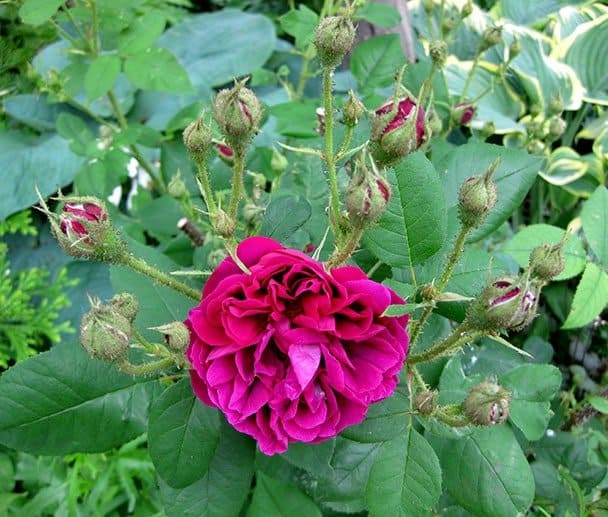
It’s nearly February, and time to consider (more like fret over) my order for bare-root roses. Growers with their own propagation fields offer a long list of interesting roses you might not find started in pots at a garden centre later in spring. When you order from a grower, you’ll receive bare-root roses in April, at just the right time for planting. Garden centres order their roses this way, too, bringing in bare-root plants and potting them up. These roses grow in the pots until you come along and purchase them, drive them home (usually breaking a stem or two in the car), and then plant them in your garden. So, a store-bought rose in a container is actually planted twice, and you only supervise the second time it’s planted. I’d rather get roses and plant them myself directly in the ground, instead of having them sit in a garden centre (where accidents and mishandling can happen). That way I can feel sure the rose gets a good start. Two sources of mail-order, bare-root roses are Corn Hill Nursery (cornhillnursery.com) in New Brunswick and Old Rose Nursery (oldrosenursery.com)in British Columbia.
I’ve ordered many bare-root roses from growers and always received healthy plants. They arrive in a heavy plastic bag, with tight, pink leaf buds and roots packed in moist shredded paper, vermiculite or sphagnum moss, all contained within a heavy cardboard shipping box. The roses are lifted from fields in November, and placed in cold storage over winter. Sometimes I need to keep them for two or three days in the cold garage until I have time to plant (keeping them cold is essential). I open the bag just a bit to allow air movement, but it’s important to keep the packing material around the roots, so they stay moist. I dig a hole wide enough to accommodate the roots when spread out and deep enough so that the grafted union will be two to four inches (5 to 10 cm) below ground level when planted. I mix the excavated soil with composted manure, peat moss and a handful of alfalfa pellets (a source of triacontanol, a natural growth hormone), fill in the hole and water in the shrub. I don’t fertilize or use transplant solution until the rose has a good flush of foliage—feeding before the leaves sprout will burn roots.
The list of available rose categories and cultivars is large, and you can follow your heart or your nose or whatever guides you in rose choices. My special interest is moss roses (Zone 5), with sticky buds covered in tiny balsam-scented hairs. (The hairs are individual scent glands, each producing a small drop of scented resin.) They’re often depicted on hand-painted plates from the Victorian era, and are grouped with heirloom or old roses. Moss roses are mutations of Centifolia roses, and have fully double flowers in a range of colours from white, through pinks and crimsons, and into deepest purple. They’re all highly scented and most bloom once in summer, although there are several that are repeat blooming like bright pink ‘Salet’ and deeper pink ‘Rene d’Anjou’ (pickeringnurseries.com). The summer-blooming sequence lasts about six weeks, and the rose puts all its energy into a prolonged and generous display. Summer-blooming roses are perfect for my garden, because they peak before Japanese beetles get into full munching mode. My favourite moss rose is ‘Etna’ (named for Mount Etna, the Sicilian volcano), a double, deepest crimson-purple flower with strong perfume. If I was ever to see a Japanese beetle enjoying a meal on my ‘Etna’ rose, well, I just can’t be responsible for what would happen. Although the moss category goes back many centuries, the roses have so much appeal and many healthy genetic characteristics that they’re still being hybridized. Modern moss roses include the summer-blooming dark red-mauve ‘Black Boy’ (hortico.com) and fire engine-red ‘Fuzzy Wuzzy Red’ (pickeringnurseries.com), which repeats freely all season.
Stachys: another useful plant

I like groundcover plants with character — well-defined foliage, stand-up posture and colour — and absolute dependability. The familiar lamb’s ears (Stachys byzantina, Zone 5) make thick mats of silken grey foliage that are effective groundcovers in positions with full sun to part shade, and everyone loves to feel their soft, hairy surface. What’s more, there’s little that interferes with their performance, so I feel confident having them in a prominent position. Fortunately, this plant has been made even more useful with the introduction of attractive cultivars. ‘Primrose Heron’ emerges in spring with bright chartreuse leaves, eventually fading to green in summer heat. ‘Sheila McQueen’ is a compact selection with smoother leaves (less fine hair); and ‘Big Ears’ (syn. ‘Countess Helen von Stein’) is the largest, with bold grey leaves forming a large mat. For several years I’ve enjoyed a large patch of the Countess along my front walkway, and for my money, she’s the most eye catching. (All the Stachys selections bloom with strange flower spikes, which I snap off.)
Stachys is an attractive companion to hostas with blue-green foliage, and the green and white leaves of ‘Jack Frost’ Siberian bugloss (Brunnera macrophylla ‘Jack Frost’, Zone 4). These plants enjoy the same light and soil conditions (well-drained clay loam amended with shredded leaves), and are companionable together the whole growing season. And I’m happy, too!
It’s nice to see you again at Making a Garden. I hope you’ll stop back next week.









You won't regret this! The selection of rose cultivars is huge when you get them bare root. I've learned so much this way, trying all kinds of rose categories. I can't grow the hybrid teas, and it seems so much floor space is given to them I hope you find some interesting shrubs, and they do well this season. And yes, Pickering Nurseries (pickeringnurseries.com) is a good place to look; they have 'Fuzzy Wuzzy Red'.
You’ve tempted me to finally try…don’t forget Pickering Nurseries. Their full colour catalogue is wonderful with a massive collection. Ann Boyd